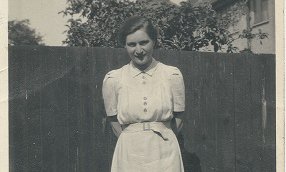Lessons for lockdown from Early Modern convents
by Dr Victoria Van Hyning
14 May 2020

If anything prepared me for life in lockdown during COVID-19, it was researching my book Convent Autobiography: Early Modern English Nuns in Exile. I knew from this work that people can live satisfying and complex lives within restricted circumstances, that routines and a sense of shared purpose are important – and that there’s room to develop a deeper understanding of ourselves as individuals and as members of society, once we’ve stripped away so much of what once occupied and shaped our former lives.
The women who established or joined the English convents on the Continent and in America between the 1530s and 1800s took huge personal risks. Leaving home to join a convent was illegal and could result in fines or imprisonment, yet nearly 4,000 women did so in order to take vows of poverty, chastity and perpetuity, meaning they promised to stay in their convents for the rest of their lives.
Most convents required new nuns to ceremonially ‘die to the world’, meaning they would radically reduce the amount of contact they had with friends and family outside their cloister to focus on their relationship with God and their new spiritual community. Winefrid Thimelby, who served as Prioress of St Monica’s Augustinian Convent in Louvain from 1668-1690, beautifully articulates what separation and absence from loved ones meant to her in a letter to her sister Katherine back in England:
it is my dayly comfort to remember how fast we approach each other: & that every moment dispatches some part of the way, this makes me content with present absence nay even love it [...] you must give me leave to love our seperation because it helps to secure an eternall mutuall injoying
Her annual letters to family consistently expressed her hope that her sacrifice would benefit them all and was worth the price of distance. Thimelby manages to transform what was no doubt a difficult separation into an expression of love and hope for an eternal family reunion.
Convent research
Over the last decade I’ve visited dozens of archives and libraries and clocked around six weeks of time in cloisters. These are surprisingly busy places with each member working towards some aspect of the life of the community: beekeeping, bookkeeping, cooking, cleaning, teaching, looking after guests, providing pastoral care. These varied activities are held together by a daily routine of both communal and individual prayer.
My long hours in the archives and quiet evenings were punctuated by communal meals with nuns, monks, or other guests, some taken in complete silence or listening to someone read from a devotional or theological book. I was always struck by the centrality of books and history to convent life, and the sense of continuity with past community members. Gaining a glimpse of present-day monastic practice shed light on the intended audiences and methods of reading for the texts and people I study. As many of us are learning to do now, from the confines of our home, nuns made their own entertainment and their own educational materials. Translations of devotional texts by nuns such as Catherine Holland were likely read aloud during communal meal or work times, during her lifetime and beyond.
The convert’s new normal
Holland was born in England in 1637 to a Protestant father and a Catholic mother. She converted to Catholicism in her late teens and ran away from home in her twenties to join the English Convent of Nazareth in Bruges where, in addition to translations of theological works and saints lives, she wrote an autobiography about her conversion and dedicated it to her fellow nuns. I include her conversion narrative as an appendix to Convent Autobiography – it’s an engaging exploration of obedience, traditional gender roles, and the rights of religious minorities. Holland is funny, sarcastic and a little melodramatic; her struggles to adapt to convent life feel resonant to me now.
Some of her original prayers give us insight into how she tried to make her peace with her new way of life. She says that “Too little Esteem of the Laws, and Institutions, and not to value the committing small Faults, which breeds Tepidity, and Relaxation, [...] makes a Regular Life tedious.” In other words, she wanted to commit to the way of life she’d chosen, rather than trying to cheat or bend the rules, which would make her life harder in the long run.
What wouldn’t I do for a garden?
Lockdown has also made me think differently about some of the people and the conflicts I wrote about. Of all the women I studied, I found Prioress Lucy Herbert (1669–1744) of Nazareth the most problematic. As Prioress from 1709 to 1744 she wrote the convent’s chronicle entries, which was a real source of power. The common monastic practice of writing anonymously allowed her to present her point of view as more widely held than evidence from other documents reveal it to have been. I call this kind of shaping of a text by an anonymous writer ‘subsumed autobiography’: the person merges their point of view into the text to such a degree that it’s really about them, not some dispassionate view of events. This kind of autobiography isn’t always negative, as the work of other chroniclers explored in Convent Autobiography reveal, but in Herbert’s case, anonymity was just another way of asserting her power.
Now, from the perspective of lockdown in an urban flat in Washington DC, I feel greater sympathy for Herbert, who was criticised by her successor for courting benefactors and having too much contact with outsiders. Herbert used their money to dramatically expand the convent buildings and gardens. She poshed up the church and expanded the school and the nuns’ recreational spaces. Her acquisitiveness and worldliness seemed distasteful to me once, but now I wonder – what wouldn’t I do to widen the bounds of my enclosure? What might I have done in Herbert’s shoes, to expand the territory of my cloister if it contained 50 women in a relatively small space, all day, every day, year on year, for the remainder of our natural lives? I appreciate Herbert’s pragmatism now in ways I simply couldn’t have before the coronavirus. So, I suppose that’s a very thin silver lining. I’ll take it.
Dr Victoria Van Hyning is Senior Innovation Specialist at the Library of Congress, where she works on a crowdsourcing transcription project called By the People. In August 2020 she will begin a new role at the University of Maryland Information School as Assistant Professor of Library Innovation. She received a British Academy Postdoctoral Fellowship in 2015. Her book Convent Autobiography: Early Modern English Nuns in Exile was published in 2019 by Oxford University Press.


